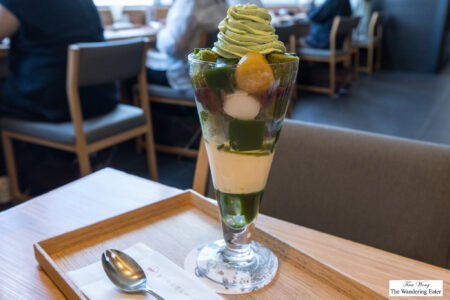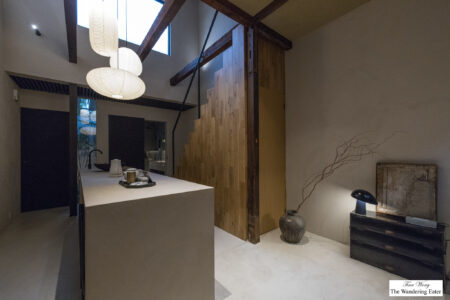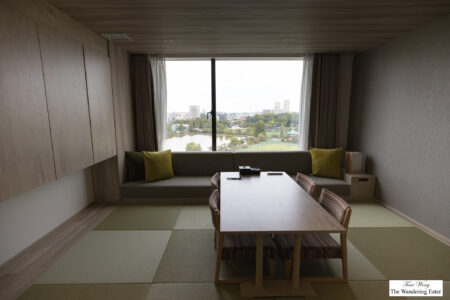Since Mid-Autumn Festival is approaching, the most common and traditional pairing is mooncakes served with hot tea to aid digestion. If you never had a mooncake, it’s a very dense confection that needs the hot tea to cut through its thick, rich texture while the tea can bring some of its own flavors to your palate.
As many of you my readers, are correct to presume I am a coffee nerd. Obsessed and sometimes fastidious to every minute detail about how my coffee should be. What you don’t know is that I’m reared with various Chinese teas my entire life after the young age of 3. I’m talking beyond the medicinal/herbal teas like chrysanthemum tea (菊花茶) that my parents simmer in large stockpots when I have a sore throat. Some of the fine teas I’ve drank over the years are Da Hong Pao tea (大红袍), Lapsang Souchong (正山小种), Iron Buddha tea (鐵觀音茶), Dragon jasmine pearl tea (龍珠茉莉花茶), Tieguanyin tea (鐵觀音), Longjing tea from Hangzhou (杭州龙井茶), and many other types of oolongs and black teas (which is called “red tea” in Chinese).
Back when I was a wee kid, was sometimes took for granted about the teas since I drank it every day. One of my aunts, Amy who is in the tea and French Cognac businesses in Hong Kong, sends shipments to my family of teas she’s fancying at the moment, a certain tea my mother wanted, or a mixture of both.
For those of you who aren’t familiar with tea, China is the birthplace of tea. It is one of the largest tea growing countries in the world and arguably, produces the best as most teas (at least the ones I’ve drank over the years) are hand rolled. Chinese teas are typically grown in the mountainous provinces of Anhui (安徽省), Fujian (福建省), Guangdong (广东省), Guangxi (广西壮族自治区), Jiangsu (江苏省), Jiangxi (江西省), Yunnan (云南省), and Zhejiang (浙江省). Very good to superior teas should be purchased from reputable tea vendors or tea houses. (I’m not going to bog you down with too much facts about the whole tea business and get to the point. I will be writing a post about Western-style teas in the near future.)
Da Hong Pao (大红袍; translated as “Big Red Robe” tea) is one of the most expensive (some sold for $30,000 per kilogram) and famous teas from the Wu Yi Mountain in the province of Fujian, China. Part of the reason why it’s so expensive is because it is rare and production costs are expensive as it is considered an artisan tea. Only a few kilograms of this tea are made every year and some of it is reserved for the government.
This deep, coppery red cup of tea smells like dark cocoa and earthy. When you take a sip, you have a hint of earthiness, with a touch of copper, a hint of roasted peach. It’s almost impossible to over-steep this tea (trust me, I’ve done this too many times) and it may be steeped multiple (up to five or six) times and result in an elegant, medium-bodied cup of tea. This tea is usually reserved for special occasions.
Lapsang Souchong (正山小种) is originally from the Fujian province of China (as this batch of photographed tea originated). This particular cup of tea is quite bold, smoky, like burning campfire pine wood rather than tobacco, and quite full-bodied texture. I like the complex smokiness of this tea and it’s better with desserts to cut the sweetness and richness.

Tieguanyin tea (鐵觀音); Limited edition on the left and the typical version on the right
Tieguanyin or Iron Buddha tea (鐵觀音) is a classic, go-to tea in my family. It’s a premium grade oolong tea originally grown from the Anxi in Fujian province. It’s refreshing, floral, light-bodied, faintly green tea. If you’re new to drinking Chinese teas, this would be a good gateway.
From the photos you see above, the one of the left with the beige colored tin is by the Anxi Tiekuanyin Group established in 1952. It is a limited edition tea exclusively for the Shanghai Expo 2010, served and sold at the United Nations Pavillion. This particular tea was notably better than the one photographed on the right (it’s slightly inexpensive than the limited edition) it’s smoother yet more complex flavored.


Dragon jasmine pearl tea (龍珠茉莉花茶)
Dragon jasmine pearl tea (龍珠茉莉花茶) is hand rolled jasmine flowers (some manufacturers mix jasmine blossoms with oolong tea) from the Fujian province. One should be careful about the amount of tea you steep since it may result in an overwhelming cup of edible jasmine perfume. If done correctly, it’s mildly sweet and floral.


Longjing tea from Hangzhou, China (杭州龙井茶)
Longjing tea (杭州龙井茶), my batch is from this tea’s famous region of Hangzhou, China, is a roasted green tea. There are seven grades of Longjing tea. It is considered Superior grade when the batch has uniformly large leaves and has a tight, flat shape with light green color. When it’s steeped, it creates a yellow-green brew with a grassy, smoky-sweet flavor. It tastes refreshingly light with a hint of fruit and nut combined. Besides the fact it tastes good, it’s good for you as lots of vitamin C and catechins.

Pur-eh tea from Yunnan (雲南普洱茶)
Pur-eh tea (雲南普洱茶) is famous from the Yunnan province. There are many different treatments this tea may be produced. Some are raw or aged, pressed in various shapes, which results in different grading (and cost). A very fine cup of pur-eh would taste earthy with a translucent dark red, blood-like color. If you want a good cup of pur-eh, you should avoid the tea bagged version (it comes in a pressed form, called “cake”) even though it costs more but there’s a remarkable difference in quality. As for the taste in an aged pur-eh, it’s rich and silky bodied and smooth. It is recommended for cooking, as it does impart an incredible depth of flavor to the food.
If you have a pur-eh that is aged and stored correctly, it becomes more valuable and tastes better. Think of it generally as very fine vintage wine: the better the vintage year, the better it tastes and it becomes valuable as it gets older.
This particular one you see above is a collector’s item. The pur-eh tea is pressed into a fan with a red silk tassel attached and placed in a bright orange-yellow silk lined box with a white jade stand with a certificate indicating it is a collector’s item.
Bi Luo Chun Tea (碧螺春; translated as “Green snail spring”) the Top Ten famous Chinese green tea originally grown in the Dong Ting mountain of Tai Hu, Jiangsu Province, China. It is green tea that is rolled into a tiny, tight spiral, resembling snail meat, and is harvested early spring. To distinguish an authentic Bi Luo Chun is to boil a cup of water, drop the said tea leaves into that hot liquid and it should drop to the bottom of your steeping vessel (cup or a teapot) almost immediately. Within a minute, it should impart a brown-green-yellow hue to your hot water. When you take a sip of this tea, it’s aromatic, floral and fruity flavored. It kind of gives you a taste of what spring is like in that region.
Hopefully, this guide would give you a glimpse of what fine Chinese origin teas are. With autumn starting soon (a bit too soon for me), a soothing, flavorful cup of hot tea is welcoming.
For more photos of my teas, please click through my slideshow below:
[tylr-slidr userID=”hellokitty893112″ groupID=””]http://www.flickr.com/photos/hellokitty893112/sets/72157627477289273/[/tylr-slidr]








